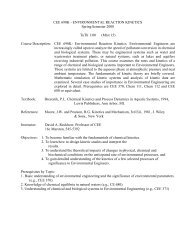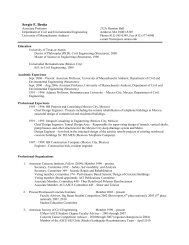Hydrograph, Pollutograph, and Thermograph Analysis of Deiced ...
Hydrograph, Pollutograph, and Thermograph Analysis of Deiced ...
Hydrograph, Pollutograph, and Thermograph Analysis of Deiced ...
- No tags were found...
You also want an ePaper? Increase the reach of your titles
YUMPU automatically turns print PDFs into web optimized ePapers that Google loves.
<strong>Hydrograph</strong>, <strong>Pollutograph</strong>, <strong>and</strong><strong>Thermograph</strong> <strong>Analysis</strong> <strong>of</strong><strong>Deiced</strong> Highway DrainageD.W. Ostendorf, E.S. Hinlein, <strong>and</strong> C. RotaruEnvironmental <strong>and</strong> Water Resources Engineering ProgramCivil <strong>and</strong> Environmental Engineering DepartmentUniversity <strong>of</strong> Massachusetts, Amherstostendorf@ecs.umass.eduInternational Conference onEnvironmental Science <strong>and</strong> TechnologyAmerican Academy <strong>of</strong> SciencesHouston, TX June 29, 2012
Overview• Institutional <strong>and</strong> physical setting• Highway drainage system, vadose zone, aquifer• Linear systems <strong>and</strong> instantaneous unit hydrographs• Specific conductivity as deicing agent surrogate• Temperature as possible third signal• Conclusions
Hobbs Brook Reservoir SubbasinPublic water supply, Cambridge Water Department
Interstate 95 Right <strong>of</strong> WayInterstate 95 right <strong>of</strong>way (Route 128),maintained byMassachusetts DOT
Deicing Agent ApplicationRoad salt (NaCl) <strong>and</strong> prewetting (MgCl 2 ) to deice the pavement
Run<strong>of</strong>f from Closed Drainage SystemCurbs, catchbasins, storm sewers: Q R , μ R
Continuous Discharge <strong>and</strong> SpecificConductivityFlow meter, potentiometric probe, <strong>and</strong> thermometer at15 minute frequency or faster. Leads to telemetry….
Telemetry <strong>and</strong> MaintenanceLocal power <strong>and</strong> dedicated l<strong>and</strong>line. To USGS online website…..
USGS
Rights <strong>of</strong> Way <strong>and</strong> WatershedsStakeholders <strong>and</strong> Agencies• Drivers dem<strong>and</strong> * bare pavement <strong>and</strong> unimpeded drivingspeeds under all conditions.• Deicing agents must interact with solid precipitation onthe pavement texture.• Drinking water users dem<strong>and</strong> * low ion concentrations insurface water supply reservoir.• Four cooperating agencies—MassDOT (I95 deicing),Cambridge Water Department (water supply), USGS(data acquisition), UMass (analysis)• *these are Boston drivers <strong>and</strong> Harvard users
<strong>Hydrograph</strong>s-Conservation <strong>of</strong> Water MassDischarge is superposition <strong>of</strong> run<strong>of</strong>f (closed drainagesystem, interflow (vadose zone), <strong>and</strong> baseflow (aquifer)QQRBaseflow <strong>and</strong> interflow are constant during storm.Run<strong>of</strong>f is absent <strong>and</strong> baseflow is constant duringinterstorm period. Run<strong>of</strong>f <strong>and</strong> interflow output are IUHconvolutions <strong>of</strong> precipitation (P) inputQIQBQR,ICR,IAR,It P( )exp[0R, I( t)] d
Run<strong>of</strong>fVery intense storm <strong>of</strong> 6-7September 2008.Calibrates the closeddrainage system decayconstant Q~Q R R1.8x104s1Hour <strong>of</strong> 6-7 September 2008IUH holds for all storms.Note the high dischargeresponse to the stormCalibrated value implies a laminar sheet flow depth <strong>of</strong> 0.5 mm,based on a 0.01 pavement slope <strong>and</strong> a 100 m distancebetween catch basins. Note the hourly response time.
InterflowVery intense storm <strong>of</strong> 15June 2006, followed by 7day interstorm period.Calibrates the vadosezone decay constantDays in June 200661 I 4.6x10sThis holds for all storms.Note the semilog plot <strong>of</strong> thehydrograph Q I
Andover I495/I93 AutosamplerSome highway sites have autosamplers along with thecontinuous probes…………..
Ion Chromatograph for Cl -Water samples may be analyzed for major cations (ICP),anions (IC, TOC), <strong>and</strong> charge balance………..
SpC to Chloride CorrelationCouples dissolved pollutographs to solid deicing agent dissolution,if chloride is the major anionic constituent (NaCl, MgCl 2 , CaCl 2 )
<strong>Pollutograph</strong>s-Conservation <strong>of</strong> SpC(Advective) flux F as product <strong>of</strong> specific conductivity<strong>and</strong> (water) dischargeFR FI FB QBaseflow flux constant during storm (Q B μ B ). Interflowflux from plowed drift (Q I μ I ). Run<strong>of</strong>f flux due todissolution <strong>of</strong> (residual) deicing agents on thepavement (μ P ) into precipitationFRCRARt P( ) ( )exp[ ( t0PR)] dWater <strong>and</strong> contaminant mass transport are coupled
Deicing Agent Dissolution KineticsElemental volume in the mm scale pavement texture (ζ)ddtPPP Zero order source strength (ω) depends on granule size,which shrinks seasonally. Kinetics determine μ P , F R
Specific Conductivity <strong>Pollutograph</strong>s 5x10m mScm sWinter SpC rises to 7 mS/cm with first flush <strong>of</strong> run<strong>of</strong>f. Strongsource <strong>and</strong> comparable interflow <strong>and</strong> baseflow concentrations.Summer SpC diluted by run<strong>of</strong>f, recovers to baseflow asymptote.Weak source, weak interflow, constant (<strong>and</strong> appreciable!)baseflow concentrations.4mS I 1. 24 ; B 2.04cm 2x105mScmm mScm smS I 0. 062 ; B 2.24cmmScm
<strong>Thermograph</strong>s-Conservation <strong>of</strong> EnergySimplest approach, just mixes the temperature streamsTQRTR QITQBaseflow <strong>and</strong> interflow temperatures vary sinusoidallyto reflect diffusive heat transfer into subsurfaceTITBTSIQBT T sin( tB )Run<strong>of</strong>f varies linearly to mimic cooling (heating) on roadTRTRO tJust a simple start: no phase change, meteorology, etc.
June 2006Hyetograph (P), hydrograph(Q), pollutograph (μ), <strong>and</strong>thermograph (T). Run<strong>of</strong>f<strong>and</strong> subsurface are hotTRO 293 K;T 288SKThe summer run<strong>of</strong>fthermograph isreasonably modeled.Subsurface thermographis periodic.
March 2006Hyetograph (P), hydrograph(Q), pollutograph (μ), <strong>and</strong>thermograph (T). Run<strong>of</strong>f<strong>and</strong> subsurface are coldTRO 281 K;T 277The winter run<strong>of</strong>fthermograph is poorlymodeled, thoughsubsurface thermographis periodic.SK<strong>Thermograph</strong> modeldoesn’t work. Yet.
Acknowledgments• MassDOT/UMass ISA 56565 funding, with USGSsubcontract to UMass for instrument maintenance <strong>and</strong>USGS website management.• Cambridge Water Department logistical support.• Nonetheless, the analyses <strong>and</strong> conclusions are onlyby the Authors. Not a specification or regulation <strong>of</strong>any Agency, local, state, or federal………….
Conclusions• Classical linear theory describes hydrographs assingle linear reservoirs for closed drainage, vadosezone, <strong>and</strong> aquifer. Simple, accurate, <strong>and</strong> physicallyplausible decay constants.• Surface run<strong>of</strong>f pollutograph dominate specificconductivity in winter, much weaker in summer—baseflow is stable <strong>and</strong> appreciable year round.• <strong>Hydrograph</strong> <strong>and</strong> specific conductivity pollutographanalyses are coupled <strong>and</strong> well established—<strong>and</strong>useful for deicing agent fate <strong>and</strong> transport modeling.• <strong>Thermograph</strong> model too simple to recover winterrun<strong>of</strong>f data. As yet unproven.
References (Proceedings Paper)• Gelhar, L.W. <strong>and</strong> J.L. Wilson, 1974. “Groundwater quality modeling”. Groundwater,12(6): 399-408.• Granato, G.E. <strong>and</strong> K.P. Smith, 1999. “Estimating concentrations <strong>of</strong> road saltconstituents in highway run<strong>of</strong>f from measurements <strong>of</strong> specific conductance”. WRIRept. 99-4077. USGS, Northborough, MA, 22 pp.• Nash, J.E., 1959. “Systematic determination <strong>of</strong> unit hydrograph parameters”. J.Geophys. Res., 64(1): 111-115.• Ostendorf, D.W., D.C. Peeling, T.J. Mitchell, <strong>and</strong> S.J. Pollock, 2001. “Chloridepersistence in a deiced access road drainage system”. J. Environ. Qual., 30(5):1756-1770.• Ostendorf, D.W., E.S. Hinlein, D.P. Ahlfeld, <strong>and</strong> J.T. DeJong, 2006. “Calibratedmodels <strong>of</strong> deicing agent solids, pavement texture, <strong>and</strong> specific conductivity <strong>of</strong>highway run<strong>of</strong>f”. J. Environ. Eng., 132(12): 1562-1571.• Smith, K.P., 2007. “Hydrologic, water quality, <strong>and</strong> meteorological data for theCambridge, MA, drinking water source area, water year 2005”. OF Rept. 07-1049.USGS, Reston, VA, 119 pp.• Waldron, M.C. <strong>and</strong> G.C. Bent, 2001. “Factors affecting reservoir <strong>and</strong> stream waterquality in the Cambridge, MA drinking water source area <strong>and</strong> implications forsource water protection”. WRI Rept. 00-4262. USGS, Northborough, MA, 89 pp.
















